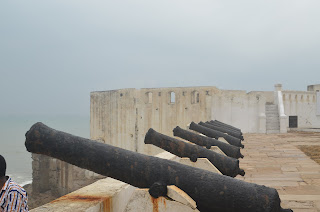Senegal, Ghana and Nigeria were major trading posts for
Trans Atlantic slave trade. While we visited
Badagry, Lagos Nigeria post in 2016, this year we wanted to visit the other major posts: Ghana and Senegal. More than 20 million slaves were transported to the Americas as part of the Trans Atlantic Slave Trade from these posts.But-for the abolition of slave trade in the 1800s, our history would not be what it is today.
Amaka's report on these posts.
The Slave Trade was a huge business that involved the sale and transportation of Africans to other parts of the world for work. This business was active over the course of hundreds of years, and in that time, millions and millions of people were taken from their homes to strange lands where they were forced to work. I had the opportunity to visit 2 large slave posts in West Africa this summer.
We first went to Goree Island, in Senegal. I was little surprised at how small it was, and how few slaves were there. Don’t get me wrong, there were still 300 slaves there, but It was unimpressive compared to the other places that I had seen and heard about. There were 20-30 slaves per room in Gorre, and in Badagry, Lagos, there were 50-60 slaves in a room of the same size. I just thought that it was quite small, especially after we went to Cape Coast in Ghana.
Cape Coast is a large castle that housed about 3,000 slaves at any given time. It was one the largest slave ports in West Africa, and one of the busiest. In the peak season, there would be one ship coming in about every two weeks. In the low season, there would be one every 3 months. This was different from Goree, where they would have one ship every 3 months throughout the whole year. We had the opportunity to enter the male slave dungeons at Cape Coast. They had 4 chambers, and each had about 300 men in it at a time, for a total of about 1,200 men. They stayed down there for the whole time, getting food through holes in the walls, and urinating, defecating, vomiting, and dying down there in the darkness. At the end of the dungeon, there was an arch that the slaves would walk through to get to the point of no return, and the ships to take them to an unknown destination. The female dungeons were very similar, except there were 2 separate rooms, each slightly bigger than one of the chambers in the male dungeons, that housed 400 women each.
Perhaps the worst things in Cape Coast were the punishment rooms. There was a female punishment room where about 5 women were placed in for a number of days, with food once a day, and no way to get out, as a punishment. And then there was the room for people who misbehaved more than once. Once you went in that room, there was no coming out. There were 3 different doors leading to that room, and the walls were more than a foot thick. ABout 10 men were chained together and put in this room for 3 days. No food, no water, no air, no ventilation. And this room was hot. I was in there for about one minute, and I was already feeling hot and claustrophobic. I couldn’t imagine that place with 10 other people in the dark for days. They basically threw you in there to die. It wasn’t as if you died alone, either. If you stayed alive until the third day, but the person next to you died on the first day, you would be laying next to a decaying corpse for literally days in the dark. I shudder just to think of it.
The thing that made me mad was that the people that traded the slaves and the governor, and the soldiers, were all living right above all of this. They were living comfortable in their palace with servants and everything they want, but just below them, people are screaming, crying, dying, and being treated like animals. There was even a chapel there. The chapel was directly above the male dungeons in Cape Coast. The slaves listened to the people above them praising God, as they were going through hell on earth. How Ironic.
The slave posts were a good experience. Though the things that happened there were terrible, it is important to learn about what happened to our ancestors, and learning to be grateful for the opportunities that we have in our lives.
Chiamaka Nwokocha, August 2017
Goree Island, Senegal
with the point of no return in the background
inside one of the dungeons
Point of No Return:
Cape Coast, Ghana
The Slave Trade merchants of Ghana took the slave trade to an industrial level never seen before their time. While the other posts--including Goree, were posts converted to handle humans, Cape Coast castle was conceived and built mainly for slave trade. Constructed without cements, the structures were very solid and impenetrable. It has observations posts and canons facing any invading force. The post changed hands several times, as a result of fights for the very profitable locations
panoramic picture of the Cape Coast Castle/fort
Selfie @ Cape Coast
 |
| Selfie @ Cape Coast |
Holding facility for slaves, later converted to rain water storage.
Inside the cell--exhibition of different heads, representing people from all parts of Africa, who were victims of the slave trade tragedy. Virtually, all African tribes and nations were impacted.
The gate of no return..this was renovated to allow for ship cargo at the end of the slave trade era.
View of the port from the gate;
How thick were the walls? very

































































